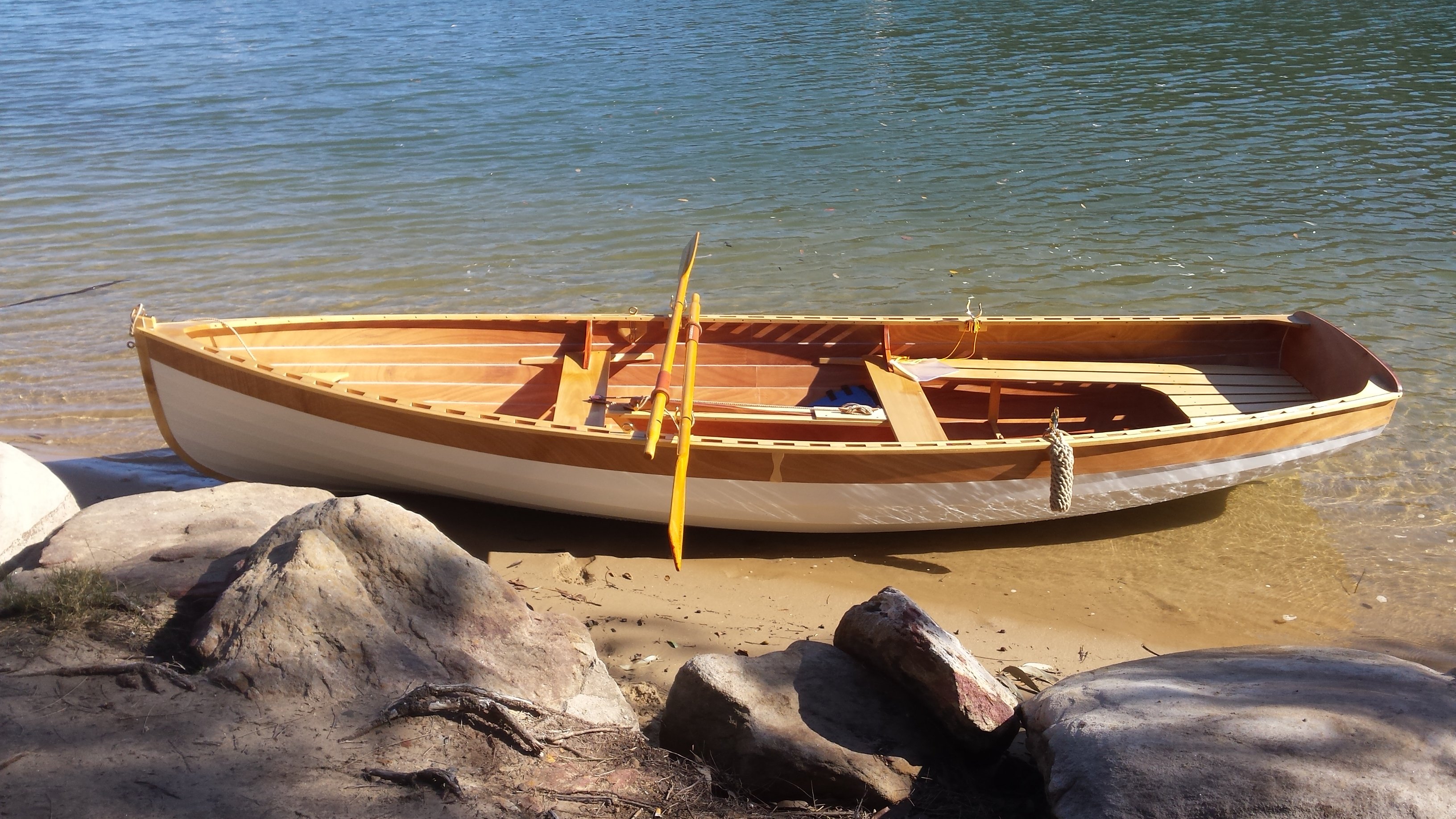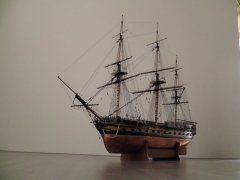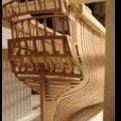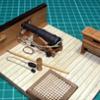MORE HANDBOOKS ARE ON THEIR WAY! We will let you know when they get here.
×
-
Posts
1,281 -
Joined
-
Last visited
Reputation Activity
-
 Bedford got a reaction from Shazmira in San Francisco 2 by Shaz - FINISHED - Artesania Latina - Wood
Bedford got a reaction from Shazmira in San Francisco 2 by Shaz - FINISHED - Artesania Latina - Wood
Excellent tutorial Wayne. The only thing I would add is that I bend a piece of brass wire that will fit through the holes in the dead eyes into a U shape such that I can feed it through a hole in the bottom dead eye and another in the top dead eye.
This holds them all at the same height when you are setting the length of the shroud.
Do it with the dead eyes the wrong way up so the single hole is at the top on the shroud table and the bottom on the shroud, ie two holes closest together, that way you only need a single brass wire to locate, if you try and do it with the dead eyes in the correct orientation you need two brass wires twisted together and exactly aligned to hold both dead eyes by two holes to stop them rotating as you apply tension.
Remember when bending the brass wire that when you rotate the dead eyes back to their correct orientation the gap between the two dead eyes will increas marginally.
Make sense ?
As for building a pinnace, all I can say is when telling your pupils, and friends for that matter, be very very concise with your pronounciation.
-
 Bedford got a reaction from Shazmira in Istanbul Kayigi by Ilhan Gokcay - FINISHED - 1:50 Scale - Coastal trade vessel of Istanbul 18th c.
Bedford got a reaction from Shazmira in Istanbul Kayigi by Ilhan Gokcay - FINISHED - 1:50 Scale - Coastal trade vessel of Istanbul 18th c.
I looked at this because the name suggested it would be something different.
The lines of the hull are beautiful and got my continued attention.
The build itself is inspiring!
Pity there is no dialogue but the pictures do speak for themselves and the tell a very interesting story.
I am familiar with the "strong back" concept for building real boats but have never seen it used for a model and I love the idea, espacially useful for any open boat build. I have a few long boats and whale boats in my future and was wondering how I was going to build them to a standard I would be happy with which kits rarely live up to with these acilliary boats.
So many lessons learned, the heat sink on the soldering iron is another good one.
Thanks so much.
Steve
-
 Bedford got a reaction from Shazmira in San Francisco 2 by Shaz - FINISHED - Artesania Latina - Wood
Bedford got a reaction from Shazmira in San Francisco 2 by Shaz - FINISHED - Artesania Latina - Wood
I never spray a tallship, always brush, you are less likely to get runs from trying to get coverage into all the nooks and crannies.
I would build all the masts and yards etc then varnish them then fit them. So much easier to work on all of it that way.
I do two coats because the first stands the grain up and makes it rough, a light sand and a second coat and all is well.
Only other tip at this point is don't just tie knots. Do proper knots, it will look so much better when finished.
I wrap the shroud around the deadeye and squeeze the end back onto the shroud with a tiny bit of pva glue on my fingers. This will hold the ends together and I then wrap black thread around the shroud from the deadeye upwards for about the same length as the diameter of the deadeye and then tie it off and put a little more pva on my fingers and rolling the bound joint between my fingers to work the glue into the binding and it will never let go.
-
 Bedford got a reaction from augie in San Francisco 2 by Shaz - FINISHED - Artesania Latina - Wood
Bedford got a reaction from augie in San Francisco 2 by Shaz - FINISHED - Artesania Latina - Wood
I never spray a tallship, always brush, you are less likely to get runs from trying to get coverage into all the nooks and crannies.
I would build all the masts and yards etc then varnish them then fit them. So much easier to work on all of it that way.
I do two coats because the first stands the grain up and makes it rough, a light sand and a second coat and all is well.
Only other tip at this point is don't just tie knots. Do proper knots, it will look so much better when finished.
I wrap the shroud around the deadeye and squeeze the end back onto the shroud with a tiny bit of pva glue on my fingers. This will hold the ends together and I then wrap black thread around the shroud from the deadeye upwards for about the same length as the diameter of the deadeye and then tie it off and put a little more pva on my fingers and rolling the bound joint between my fingers to work the glue into the binding and it will never let go.
-
 Bedford got a reaction from avsjerome2003 in San Francisco 2 by Shaz - FINISHED - Artesania Latina - Wood
Bedford got a reaction from avsjerome2003 in San Francisco 2 by Shaz - FINISHED - Artesania Latina - Wood
I never mind a question, hell, I have asked thousands !!
If your solder says "solid" then it is not resin cored and you would need flux. Personally I would consign it to Davey Jones' Locker and buy some resin cored.
Resin cored will say "resin cored" and if it is an old roll and you can't read the label then pull on the end, stretch it until it breaks. You should be able to see the resin cores. There are normally a few cores that are like veins running through the length of the solder. It is brown so easy to see. If not sure then heat up the iron and melt some solder, the resin will become apparent as a brown fluid around the solder.
-
 Bedford got a reaction from avsjerome2003 in San Francisco 2 by Shaz - FINISHED - Artesania Latina - Wood
Bedford got a reaction from avsjerome2003 in San Francisco 2 by Shaz - FINISHED - Artesania Latina - Wood
OK ! Soldering.
I am an electrical fitter, I have made thousands of solder joints with copper and 60/40 resin cored solder.
Forget silver solder for non load bearing joints, you don't need it and it may require specialised heating implements and flux.
Copper is made to be soldered with 60/40 resin cored, they go together like peas in a pod.
Use a mains powered iron, 25watt should be good.
MAKE DAMN SURE THE COPPER IS CLEAN!!!!
I use wet and dry sanding paper to make it shiny and don't touch it where you are going to solder.
Do not set it up on a wooden board unless you are well and truly used to doing it as if you take too long the wood will start to burn and the smoke will wreck the joint.
DO put solder on the iron first, just a little, this increases the contact area between the iron and the job and the heat transfer is much more efficient. For small jobs you may find the initial blob of solder on the iron is sufficient, you will see it flow onto the joint when the job is hot enough.
Solder flows to heat so if you need to add more to the joint then do so on the edge of the joint and it will flow in.
If I was doing those joints I would use a wood base but use a household tile and after sanding the copper clean bend the "U" with tools and leave long ends on it so you can tape it down. Then bend a very short right angle into the shaft part and tape it down so the "L" is in place against the "U" The reason for the "L" is to give more contact area to the joint.
Meanwhile the iron has been getting hot.
Touch the solder to the iron and if it melts quickly the iron is hot enough, touch the solder carrying face of the iron to the job and hold until you see the solder flow. You can add more and if it only flows to such an extent that the blob has ceased to be a blob and started to flow but wont spread then definately touch a bit more solder onto the joint because that will add flux and help the solder flow.
If you get the joint hot enough then when you remove the iron I would drag it down the shaft and this will thin the excess solder down along the shaft rather than leaving a huge blob. It is worth noting that solder has a high lead content so use it in a well ventilated area but more interestingly to modellers, it can be trimmed with a sharp knife. ROBBYN, BE VEWY, VEWY CAREFUL
I made this using an electric iron as well as a larger gas heated iron, it was 50/50 from memmory, resin cored solder.
Fitted to a 3.5Kg vehicle, I can lift the car by the bullbar and it is brass, not copper, copper is easier to solder.
-
 Bedford got a reaction from lamarvalley in San Francisco 2 by Shaz - FINISHED - Artesania Latina - Wood
Bedford got a reaction from lamarvalley in San Francisco 2 by Shaz - FINISHED - Artesania Latina - Wood
I never mind a question, hell, I have asked thousands !!
If your solder says "solid" then it is not resin cored and you would need flux. Personally I would consign it to Davey Jones' Locker and buy some resin cored.
Resin cored will say "resin cored" and if it is an old roll and you can't read the label then pull on the end, stretch it until it breaks. You should be able to see the resin cores. There are normally a few cores that are like veins running through the length of the solder. It is brown so easy to see. If not sure then heat up the iron and melt some solder, the resin will become apparent as a brown fluid around the solder.
-
 Bedford got a reaction from realworkingsailor in San Francisco 2 by Shaz - FINISHED - Artesania Latina - Wood
Bedford got a reaction from realworkingsailor in San Francisco 2 by Shaz - FINISHED - Artesania Latina - Wood
OK ! Soldering.
I am an electrical fitter, I have made thousands of solder joints with copper and 60/40 resin cored solder.
Forget silver solder for non load bearing joints, you don't need it and it may require specialised heating implements and flux.
Copper is made to be soldered with 60/40 resin cored, they go together like peas in a pod.
Use a mains powered iron, 25watt should be good.
MAKE DAMN SURE THE COPPER IS CLEAN!!!!
I use wet and dry sanding paper to make it shiny and don't touch it where you are going to solder.
Do not set it up on a wooden board unless you are well and truly used to doing it as if you take too long the wood will start to burn and the smoke will wreck the joint.
DO put solder on the iron first, just a little, this increases the contact area between the iron and the job and the heat transfer is much more efficient. For small jobs you may find the initial blob of solder on the iron is sufficient, you will see it flow onto the joint when the job is hot enough.
Solder flows to heat so if you need to add more to the joint then do so on the edge of the joint and it will flow in.
If I was doing those joints I would use a wood base but use a household tile and after sanding the copper clean bend the "U" with tools and leave long ends on it so you can tape it down. Then bend a very short right angle into the shaft part and tape it down so the "L" is in place against the "U" The reason for the "L" is to give more contact area to the joint.
Meanwhile the iron has been getting hot.
Touch the solder to the iron and if it melts quickly the iron is hot enough, touch the solder carrying face of the iron to the job and hold until you see the solder flow. You can add more and if it only flows to such an extent that the blob has ceased to be a blob and started to flow but wont spread then definately touch a bit more solder onto the joint because that will add flux and help the solder flow.
If you get the joint hot enough then when you remove the iron I would drag it down the shaft and this will thin the excess solder down along the shaft rather than leaving a huge blob. It is worth noting that solder has a high lead content so use it in a well ventilated area but more interestingly to modellers, it can be trimmed with a sharp knife. ROBBYN, BE VEWY, VEWY CAREFUL
I made this using an electric iron as well as a larger gas heated iron, it was 50/50 from memmory, resin cored solder.
Fitted to a 3.5Kg vehicle, I can lift the car by the bullbar and it is brass, not copper, copper is easier to solder.
-
 Bedford got a reaction from Shazmira in San Francisco 2 by Shaz - FINISHED - Artesania Latina - Wood
Bedford got a reaction from Shazmira in San Francisco 2 by Shaz - FINISHED - Artesania Latina - Wood
Good on you for doing the scratch building Robbyn, in my view that's what makes you a good modeller rather than just someone how puts a kit together.
Re your bike trip I have one question.............................how are you going to safely carry the SF on a bike so you can work on it while you are there
-
 Bedford got a reaction from muzzleloader in LE BONHOMME RICHARD by Jeronimo - FINISHED
Bedford got a reaction from muzzleloader in LE BONHOMME RICHARD by Jeronimo - FINISHED
I might as well give up now, I will never be that good.
-
 Bedford got a reaction from Salty Sea Dog in San Francisco 2 by Shaz - FINISHED - Artesania Latina - Wood
Bedford got a reaction from Salty Sea Dog in San Francisco 2 by Shaz - FINISHED - Artesania Latina - Wood
Good on you for doing the scratch building Robbyn, in my view that's what makes you a good modeller rather than just someone how puts a kit together.
Re your bike trip I have one question.............................how are you going to safely carry the SF on a bike so you can work on it while you are there
-
 Bedford got a reaction from Sjors in San Francisco 2 by Shaz - FINISHED - Artesania Latina - Wood
Bedford got a reaction from Sjors in San Francisco 2 by Shaz - FINISHED - Artesania Latina - Wood
Catfalls is another term.
If you think of them as cats paws and the lines dropping from them as the cats claws you will see where the name comes from.
Now, stop dreaming and get back to work !
-
 Bedford got a reaction from DCIronfist in San Francisco 2 by Shaz - FINISHED - Artesania Latina - Wood
Bedford got a reaction from DCIronfist in San Francisco 2 by Shaz - FINISHED - Artesania Latina - Wood
I have no idea how hot a curling iron gets but I would imagine not very.
From the look of your profile pic you wouldn't have any other use for one though
-
 Bedford reacted to realworkingsailor in San Francisco 2 by Shaz - FINISHED - Artesania Latina - Wood
Bedford reacted to realworkingsailor in San Francisco 2 by Shaz - FINISHED - Artesania Latina - Wood
As long as you don't .. Uh.. bond...over crazy glue...
Sorry....couldn't help myself...
Andy
-
 Bedford got a reaction from Anja in Improving brass hinges
Bedford got a reaction from Anja in Improving brass hinges
As a result of Shazmira posting about badly formed and ill fitting rudder hinges I thought I would post my answer to the problem.
First get one of these, it is a tile nipping tool designed to help shape ceramic tiles.
I don't use brass rod for the hinge pin opting instead for brass nails supplied with the kit, cut to length and put into the hinge with the head at the top like most domestic hinges to stop the pin falling through.
Then holding the hinge pin section of the hinge with the tool, note, I did not put the pin in for the pic.
Push the tool and hinge down onto a hard edge wide enough to fill the throat of the hinge and while pushing against this crimp the hinge in around the pin. The pin should not get jammed because the brass will normally spring back just a bit.
When the pin pocket is crimped in nicely you can rebend the throat of the hinge tightly around a metal or hard wood edge that is the same thickness as the stern post or rudder using a hard straight edge to bend with to get a clean fold.
Note: if the brass is hard you can heat it until it is going red and leave to cool. This will soften it nicely but leave it discoloured, a touch of emery or steel wool will fix that easily.
-
 Bedford got a reaction from Jeronimo in LE BONHOMME RICHARD by Jeronimo - FINISHED
Bedford got a reaction from Jeronimo in LE BONHOMME RICHARD by Jeronimo - FINISHED
I was thinking the same thing, the stairs would be much easier to negotiate if they were linear.
-
 Bedford got a reaction from mtaylor in Improving brass hinges
Bedford got a reaction from mtaylor in Improving brass hinges
As a result of Shazmira posting about badly formed and ill fitting rudder hinges I thought I would post my answer to the problem.
First get one of these, it is a tile nipping tool designed to help shape ceramic tiles.
I don't use brass rod for the hinge pin opting instead for brass nails supplied with the kit, cut to length and put into the hinge with the head at the top like most domestic hinges to stop the pin falling through.
Then holding the hinge pin section of the hinge with the tool, note, I did not put the pin in for the pic.
Push the tool and hinge down onto a hard edge wide enough to fill the throat of the hinge and while pushing against this crimp the hinge in around the pin. The pin should not get jammed because the brass will normally spring back just a bit.
When the pin pocket is crimped in nicely you can rebend the throat of the hinge tightly around a metal or hard wood edge that is the same thickness as the stern post or rudder using a hard straight edge to bend with to get a clean fold.
Note: if the brass is hard you can heat it until it is going red and leave to cool. This will soften it nicely but leave it discoloured, a touch of emery or steel wool will fix that easily.
-
 Bedford got a reaction from tkay11 in Improving brass hinges
Bedford got a reaction from tkay11 in Improving brass hinges
As a result of Shazmira posting about badly formed and ill fitting rudder hinges I thought I would post my answer to the problem.
First get one of these, it is a tile nipping tool designed to help shape ceramic tiles.
I don't use brass rod for the hinge pin opting instead for brass nails supplied with the kit, cut to length and put into the hinge with the head at the top like most domestic hinges to stop the pin falling through.
Then holding the hinge pin section of the hinge with the tool, note, I did not put the pin in for the pic.
Push the tool and hinge down onto a hard edge wide enough to fill the throat of the hinge and while pushing against this crimp the hinge in around the pin. The pin should not get jammed because the brass will normally spring back just a bit.
When the pin pocket is crimped in nicely you can rebend the throat of the hinge tightly around a metal or hard wood edge that is the same thickness as the stern post or rudder using a hard straight edge to bend with to get a clean fold.
Note: if the brass is hard you can heat it until it is going red and leave to cool. This will soften it nicely but leave it discoloured, a touch of emery or steel wool will fix that easily.
-
 Bedford got a reaction from BANYAN in Improving brass hinges
Bedford got a reaction from BANYAN in Improving brass hinges
As a result of Shazmira posting about badly formed and ill fitting rudder hinges I thought I would post my answer to the problem.
First get one of these, it is a tile nipping tool designed to help shape ceramic tiles.
I don't use brass rod for the hinge pin opting instead for brass nails supplied with the kit, cut to length and put into the hinge with the head at the top like most domestic hinges to stop the pin falling through.
Then holding the hinge pin section of the hinge with the tool, note, I did not put the pin in for the pic.
Push the tool and hinge down onto a hard edge wide enough to fill the throat of the hinge and while pushing against this crimp the hinge in around the pin. The pin should not get jammed because the brass will normally spring back just a bit.
When the pin pocket is crimped in nicely you can rebend the throat of the hinge tightly around a metal or hard wood edge that is the same thickness as the stern post or rudder using a hard straight edge to bend with to get a clean fold.
Note: if the brass is hard you can heat it until it is going red and leave to cool. This will soften it nicely but leave it discoloured, a touch of emery or steel wool will fix that easily.














